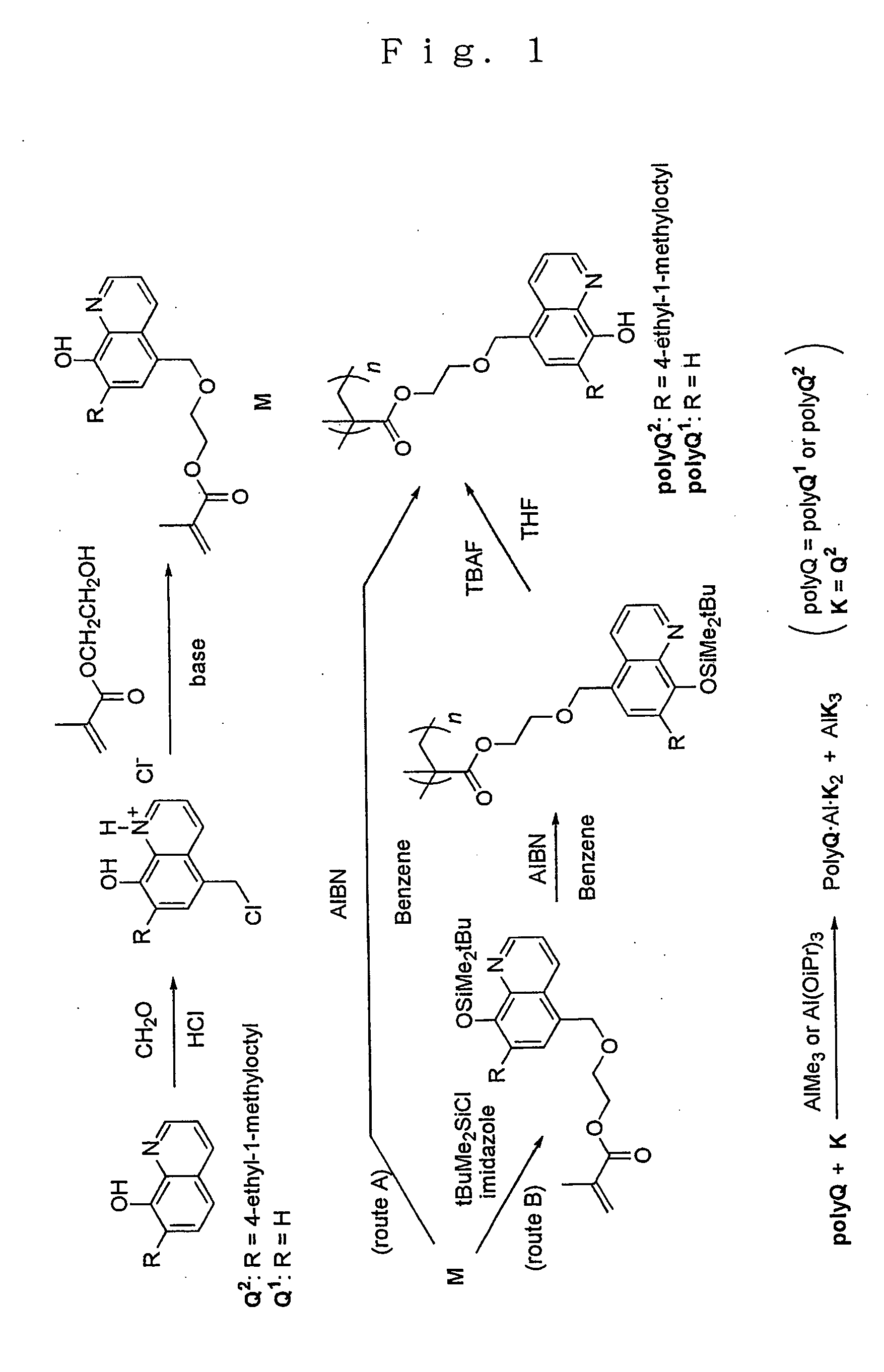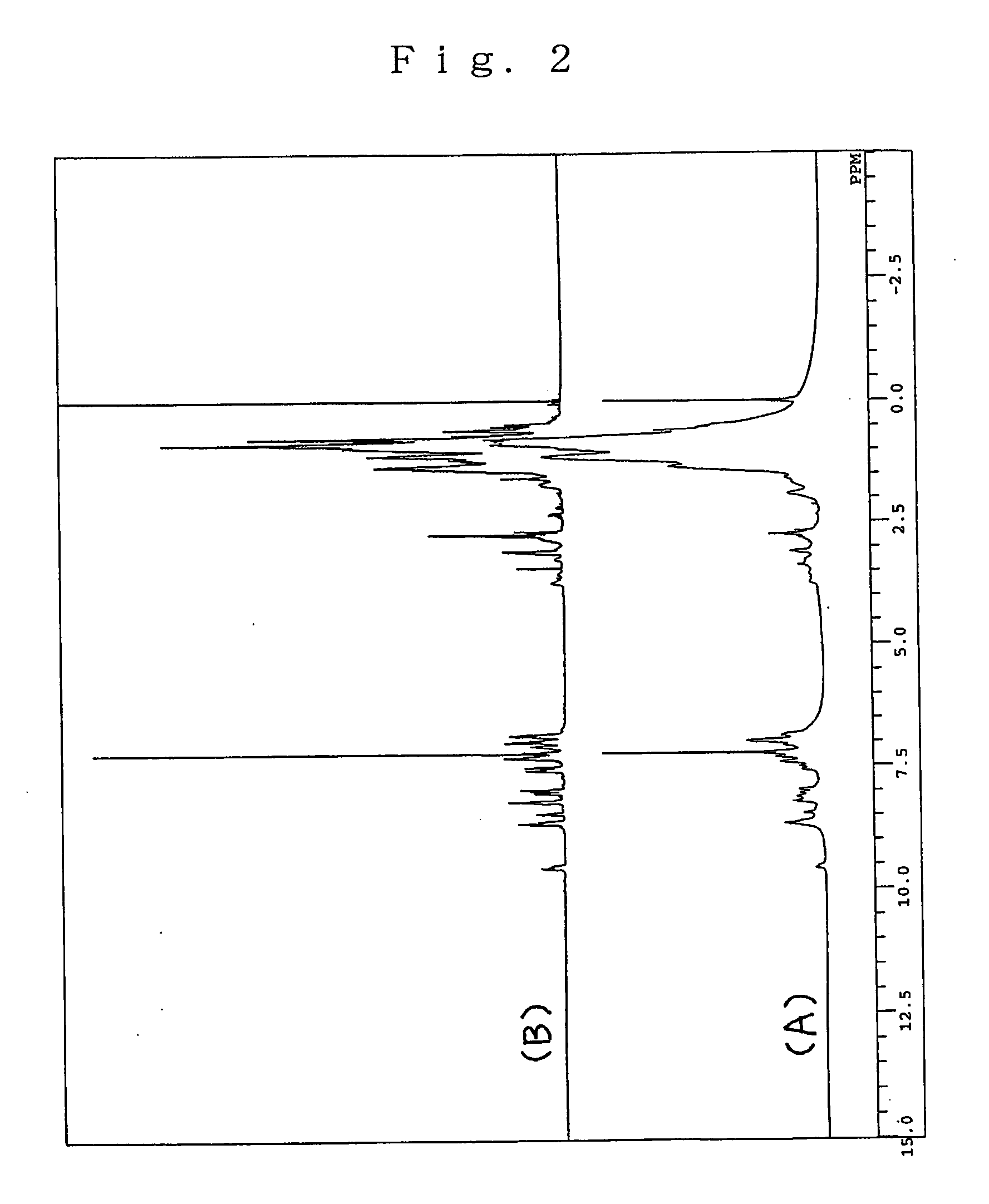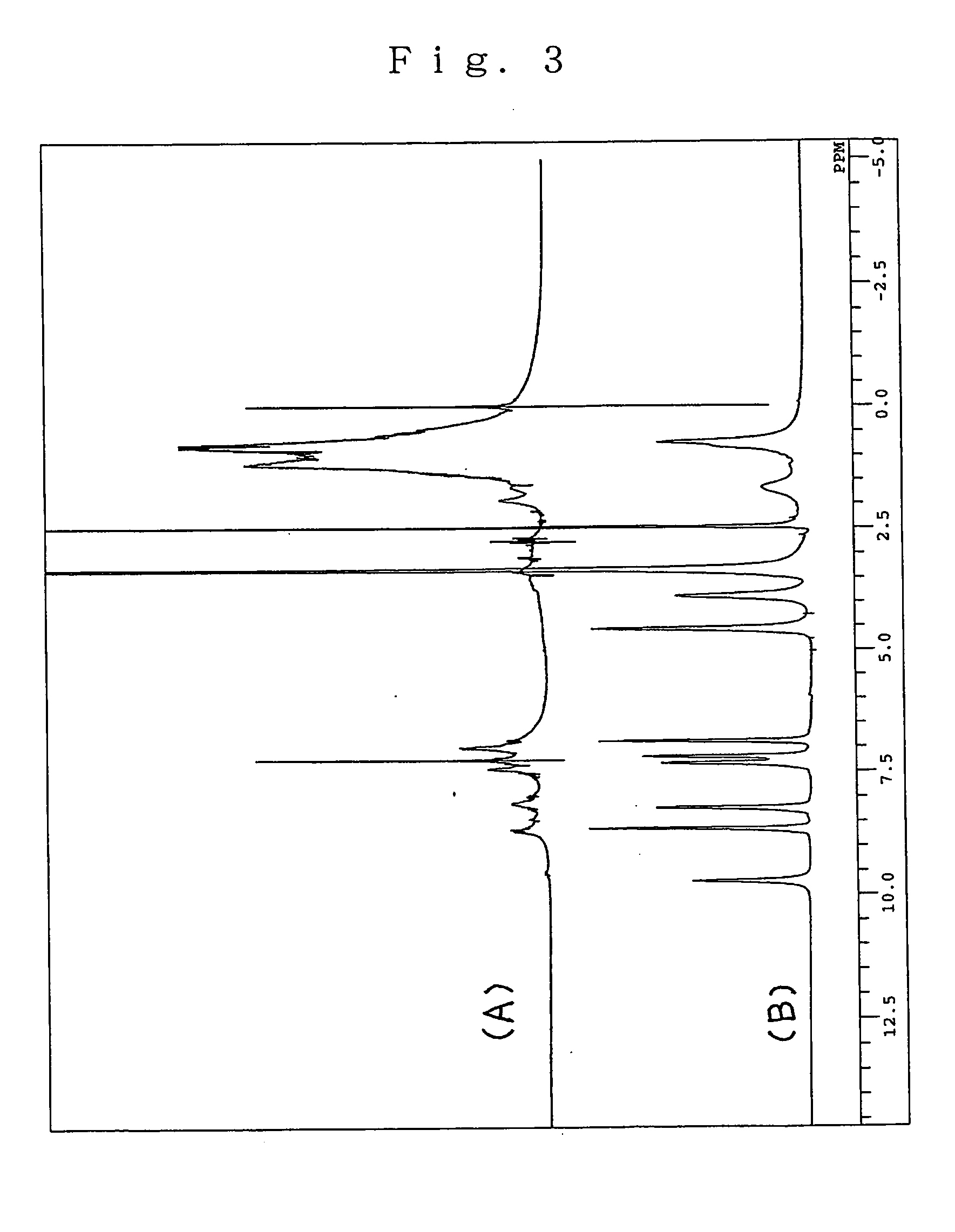Luminescent orgainc-polymer/metal complex, luminescent orgainc-polymer/metal complex composition capable of forming film by wet process, and process for producing the same
a technology of orgainc-polymer and metal complex, which is applied in the direction of luminescent compositions, solid-state devices, chemistry apparatuses and processes, etc., can solve the problems of affecting the production efficiency of large-area luminescent elements, and affecting the quality of the material. , to achieve the effect of excellent solvent solubility, excellent fastness and brightness
- Summary
- Abstract
- Description
- Claims
- Application Information
AI Technical Summary
Benefits of technology
Problems solved by technology
Method used
Image
Examples
synthetic example 1
Synthesis of polyQ 1
[0039] In a reaction vessel were placed 26.2 g (0.201 mole) of 8-hydroxyquinoline (Q1), 36 mL of concentrated hydrochloric acid and 32 mL (0.3 mole) of 28 wt % formalin and dry hydrogen chloride gas was introduced to the mixture at room temperature for 90 minutes.
[0040] After the reaction was over, the precipitates formed were collected by filtration and dried to give 37.2 g (yield 80%) of the chloromethylated product (Q1-CH2Cl.HCl) as an amorphous yellow solid. The melting point of the product was 280° C. (with decomposition) and agreed well with the literature value [280° C. (with decomposition), J. Org. Chem., vol. 26, p. 4078 (1961)].
[0041] Following this, 14.5 g (0.0629 mole) of the chloromethylated product (Q1-CH2Cl.HCl) and 60 mL (0.43 mole) of 2-hydroxyethyl methacrylate, in excess of the chloromethylated product, were placed in a reaction vessel and they were allowed to react at 60° C. for 2 days in an atmosphere of argon.
[0042] Upon completion of th...
synthetic example 2
Synthesis of polyQ2
[0048] In a reaction vessel were placed 45.0 g (0.15 mole) of 7-(4-ethyl-1-methyloctyl)-8-hydroxyquinoline (Q2), 75 mL of concentrated hydrochloric acid and 25 mL (0.23 mole) of 28 wt % formalin and dry hydrogen chloride gas was introduced to the mixture at 65-75° C. for 17 hours. The reaction product was a mixture of an aqueous layer and a dark ocherous solid.
[0049] After the reaction was over, the product was extracted four times with 100 ml of chloroform from which the stabilizer had been removed in advance and the product was reprecipitated by addition of 4 L of ether to give 23 g of an amorphous yellow solid.
[0050] The product was identified as Q2-CH2Cl.HCl (yield 57%) or Q2 chloromethylated at the position 5 on the basis of its 1H-NMR and 13C-NMR spectra.
[0051]1H-NMR (400 MHz, CDCl3): δ (ppm)=9.14 (1H, d, J=7.2 Hz), 9.04 (1H, br. s), 7.99 (1H, br. s), 7.75 (1H, s), 8.06 (2H, s), 3.68 (1H, m), 1.64 (2H, br. d, J=5.6 Hz), 1.31-1.18 (14H, m), 0.87-0.75 (6H,...
synthetic example 3
Synthesis of polyQ2
[0062] In 5 mL of dry DMF were dissolved 2.13 g (4.82 millimoles) of the product (Q2-CH2—HMA) prepared as in the aforementioned Synthetic Example 2 and 0.872 g (5.79 millimoles) of tert-butyldimethylsilyl chloride, 0.82 g (12.0 millimoles) of imidazole was added to the resulting solution with stirring at room temperature, the mixture was stirred continuously at room temperature for 10 hours, the reaction was terminated by addition of a saturated aqueous solution of bicarbonate of soda and the reaction mixture was extracted with hexane. The organic layer obtained was dried and purified by silica gel chromatography (hexane-ethyl acetate) to give 2.68 g (yield 99% or more) of a colorless oily product [Q2(OSi)—CH2—HMA] or Q2-CH2—HMA whose hydroxyl group at the position 8 had been silylated.
[0063] The 1H-NMR spectral data of the product [Q2(OSi)—CH2—HMA] were as follows.
[0064]1H-NMR (400 MHz, CDCl3): δ (ppm)=8.76 (1H, dd, 2, 4 Hz), 8.41 (1H, dd. 2, 9 Hz), 7.35 (1H, ...
PUM
| Property | Measurement | Unit |
|---|---|---|
| molar ratio | aaaaa | aaaaa |
| molar ratio | aaaaa | aaaaa |
| melting point | aaaaa | aaaaa |
Abstract
Description
Claims
Application Information
 Login to View More
Login to View More - R&D
- Intellectual Property
- Life Sciences
- Materials
- Tech Scout
- Unparalleled Data Quality
- Higher Quality Content
- 60% Fewer Hallucinations
Browse by: Latest US Patents, China's latest patents, Technical Efficacy Thesaurus, Application Domain, Technology Topic, Popular Technical Reports.
© 2025 PatSnap. All rights reserved.Legal|Privacy policy|Modern Slavery Act Transparency Statement|Sitemap|About US| Contact US: help@patsnap.com



